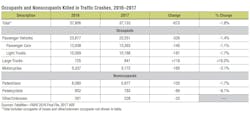Fewer die from most vehicle crashes, but not large trucks or in urban areas
Fatalities from crashes of various causes and for just about all vehicle types were down from 2016 to 2017, according to the latest data. Just about all, that is, except large trucks and urban area collisions.
Those two crash types were the standout as the National Highway Traffic Safety Administration (NHTSA) reported the latest data from its Fatality Analysis Reporting System, or FARS, yesterday afternoon. Compared to the year before, the data mostly showed good signs: fewer people died in 2017 in crashes in passenger cars (1.1%), vans (5.8%), light pickup trucks (4.5%), motorcycles (3.1%), and bicycles (8.1%).
Slightly fewer pedestrians also were killed—1.7%, the first decline in those fatalities in five years—and alcohol-impaired collisions inched down by 1.1% from 2016 numbers. Speeding-related accident fatalities were down by a more substantial 5.6%.
"After a spike in roadway fatalities in 2015 and 2016, the final data we are releasing for 2017 shows a nearly 2% decline in fatalities," said Heidi King, deputy administrator of NHTSA. "Preliminary estimates for the first six months of 2018 appear to show that this downward trend continues."
Amid all that, something strange is going on. Three percent more people were killed in SUVs, tractor-trailer crash fatalities were up 5.8%, and deaths in large straight truck wrecks ballooned up 18.7% in 2017.
The higher large truck-related fatalities weren't all among commercial vehicles that the Federal Motor Carrier Safety Administration (FMCSA) regulates, noted that agency's Administrator Ray Martinez, since it includes all trucks over 10,000-lbs. gross vehicle weight other than buses and motor homes.
"A sizeable percent of large truck fatalities occurred in vehicles which did not require U.S. [Dept. of Transportation]/FMCSA authority," he said. "Think in terms of large, dual-wheeled pickup trucks and things of that nature," he added later, pointing to a big leap in trucks on the road in the 10,000-14,000-lb. weight range.
Just volume?
Partly, the large truck fatalities are a product of traffic density and more vehicles, although many factors come into play.
"As a result of the continued strengthening of the U.S. economy, more vehicles—particularly commercial trucks—are traveling the nation's roadways," Martinez said. "It is somewhat of a corollary that as the economy grows, more vehicle miles will be traveled, and in this case we're specifically talking about commercial motor vehicles."
"The potential for crashes also increases," he pointed out.
Even so, there's apparently also a seatbelt problem among occupants in those large trucks. Some 16% more people who died in large trucks in 2017 weren't buckled up compared to the year before, the data showed. At the same time, 4.2% fewer people died in passenger cars and weren't wearing their seatbelts.
The higher road saturation and vehicle volume risk has also been driving a shift from rural to urban fatalities, however. "For the second year in a row, there were more fatalities in urban areas than in rural areas," noted NHTSA's King. Greater urban density means the variety of vehicles and people on foot there all compete for less space.
That reflects a larger population trend. Just go back to 2015 and the years before that, and more people traditionally died in rural area collisions; no longer.
Over the last decade, urban area deaths of passenger car occupants, pedestrians, motorcyclists, and bicyclists have risen by 17.4%, according to NHTSA, while over that same period, rural area crash fatalities are down 18%.
Social shifts
While alcohol-impaired fatalities were down slightly in this latest NHTSA analysis, data sources from various parts of the country are showing more drivers in crashes have other drugs like opioids, cannabis, and prescription medications in their system.
The marijuana-tinged crash increases are small surprise as more drivers in accidents test with tetrahydrocannabinol, or THC, in their blood in the growing number of states that have legalized recreational use.
In "snapshot" testing NHTSA has conducted at the roadside, King noted, "we have seen an increase in the number of drivers [in collisions] with substances in their blood—in particular, THC, some opioids, and also some prescription opioids."
"It's a very complicated issue, it's emerging very rapidly, and we're working very hard to develop the tools to support highway safety," she added. In one example, NHTSA recently launched a campaign to tell drivers, "If you feel different, you drive different" and "Drive high, get a DUI."
And at any rate, the vehicle fatality decreases don't mean roadway problems are solved by any stretch. "A one-year decrease in fatality numbers, while pleasing news, does not constitute a trend," King noted.
About the Author
Aaron Marsh
Aaron Marsh is a former senior editor of FleetOwner, who wrote for the publication from 2015 to 2019.


